41 goto and labels in c
c++ - How to store goto labels in an array and then jump to them ... In plain standard C, this not possible as far as I know. There is however an extension in the GCC compiler, documented here, that makes this possible. The extension introduces the new operator &&, to take the address of a label, which can then be used with the goto statement. Share answered Jun 2, 2009 at 8:41 unwind 380k 63 459 591 Goto in c | labels in c - bigOschools goto and labels in c. The goto statement used as for jumping from or breaking out of two or more loops at once and transfer control to the other part of the program where it is being labeled. It is different from break statement as break statement teminates the innermost loop where as it jumps from innermost loop to labeled name.
linux - Is there a "goto" statement in bash? - Stack Overflow Mar 09, 2012 · @user239558: Some languages only allow you to break or continue from the innermost loop, whereas Bash lets you specify how many levels of loop to jump. (And even of languages that allow you to break or continue from arbitrary loops, most require that to be expressed statically -- e.g., break foo; will break out of the loop labeled foo-- whereas in Bash it's expressed dynamically -- e.g., break ...

Goto and labels in c
goto statement in C/C++ - GeeksforGeeks label: | goto label; In the above syntax, the first line tells the compiler to go to or jump to the statement marked as a label. Here label is a user-defined identifier which indicates the target statement. The statement immediately followed after 'label:' is the destination statement. The 'label:' can also appear before the 'goto ... Goto Statement in C# with Examples - Dot Net Tutorials The goto statement transfers program control to a labeled statement. The label statement must exist in the scope of the goto statement. More than one goto statement can transfer control to the same label. This statement can be used to get out from a loop or an inner nested loop to an outer loop. Statements - cppreference.com Nov 01, 2021 · Two labels in a function must not have the same identifier. Labels are not found by unqualified lookup : a label can have the same name as any other entity in the program. void f ( ) { { goto label ; // label in scope even though declared later label :; } goto label ; // label ignores block scope } void g ( ) { goto label ; // error: label not ...
Goto and labels in c. goto | Microsoft Docs Syntax Copy goto Parameters Remarks If command extensions are enabled (the default), and you use the goto command with a target label of :EOF, you transfer control to the end of the current batch script file and exit the batch script file without defining a label. goto and Labeled Statements (C) | Microsoft Docs A statement label is meaningful only to a goto statement; in any other context, a labeled statement is executed without regard to the label. A jump-statement must reside in the same function and can appear before only one statement in the same function. The set of identifier names following a goto has its own name space so the names do not ... goto Statement in C with Example - Know Program The control is unconditionally transferred to the statement associated with the label specified in the goto statement. goto syntax in C. Syntax:- goto label_name; A statement label is defined in exactly the same way as a variable name, which is a sequence of letters and digits, the first of which must be a letter. Local Labels in C - GeeksforGeeks Everybody who has programmed in C programming language must be aware about "goto" and "labels" used in C to jump within a C function. GCC provides an extension to C called "local labels". Conventional Labels vs Local Labels Conventional labels in C have function scope. Where as local label can be scoped to a inner nested block.
Labels and goto — librambutan prerelease documentation Labels and goto ¶ A label gives a name to a line of code within a function. You can label a line by writing a name for it, then a colon (: ), before the line starts. The goto keyword allows program flow to transfer to a labeled line from anywhere within the same function. Warning The use of goto is discouraged in C and C++ programming. Goto Statement In C# - c-sharpcorner.com Feb 23, 2022 · C# GoTo. The goto is C# unconditional jump statement. When encountered, program flow jumps to the location specified by the goto. The goto requires a label of operation. A label is a valid C# identifier followed by colon. There are different-different ways for using Goto statement such as: We can write code for loop with the help of goto statement C goto Statement - Programiz Should you use goto? If you think the use of goto statement simplifies your program, you can use it. That being said, goto is rarely useful and you can create any C program without using goto altogether. Here's a quote from Bjarne Stroustrup, creator of C++, "The fact that 'goto' can do anything is exactly why we don't use it." syntax - Is there a goto statement in Java? - Stack Overflow Mar 30, 2010 · Although C is not the prime language to program computers with nowadays, it is still heavily used in low level applications, such as embedded systems. Because C's function so closely mirrors assembly language's function, it only makes sense that goto is included in C. It is clear that Java is an evolution of C/C++.
Goto - Wikipedia GoTo (goto, GOTO, GO TO or other case combinations, depending on the programming language) is a statement found in many computer programming languages.It performs a one-way transfer of control to another line of code; in contrast a function call normally returns control. Will a label be executed if it is written before a goto statement in C? What is the GoTo statement in C programming? The goto statement in c is known as jump statement. As the name suggests, Goto is used to transfer the program control to a predefined label. It statment can be used to repeat some part of the code in program for a particular condition. Smriti Bajaj goto statement in C and C++ Syntax1 | Syntax2 -----goto label_name; .. .. .. label_name: C-statements. The first line in the syntax above tells the compiler to go, or jump to, the statement marked as a label. The label here is a user-defined identifier indicating the target declaration. The statement followed immediately after 'label:' is the state of destination. Goto and Labels in C - Tutorial And Example A Label in C is used with goto and switch statements. A label is followed by a colon and what makes it special is that it has the same form as a variable name. Also,it can be adjoined with any statement in the same function as the goto. The label differs from the other statements of its kind is the scope.
C# goto (With Examples) - Programiz Here, label is an identifier. When goto label; is encountered, the control of the program is transferred to label:. Then the code below label: is executed. Working of goto in C#. Example: C# goto using System; namespace CSharpGoto { class Program { public static void Main(string[] args) {
C++ goto statement - Tutorials Point A goto statement provides an unconditional jump from the goto to a labeled statement in the same function. NOTE − Use of goto statement is highly discouraged because it makes difficult to trace the control flow of a program, making the program hard to understand and hard to modify.
Same goto labels used in a C file but different functions Labels are local, so you can use the same label in multiple functions. The question about if you should use goto is a different matter though, and one that is not easily answered. In short, don't use goto. But as with everything (especially when it comes to programming) there are exceptions where goto may be useful. Share
goto Statement (C++) | Microsoft Docs A statement label is meaningful only to a goto statement; otherwise, statement labels are ignored. Labels cannot be redeclared. A goto statement is not allowed to transfer control to a location that skips over the initialization of any variable that is in scope in that location. The following example raises C2362: C++ Copy
Discover Goto and Labels in C++ Discover Goto and Labels in C++ The goto statement is used to jump to a label that provides an unconditional jump from the goto to a labeled statement in the same function. We can also do the same loops as the same in for () while () loops by using goto statement.
GOTO command and command labels in a CL program or procedure A label identifies the statement in the program or procedure to which processing is directed by the GOTO command. To use a GOTO command, the command you are branching to must have a label. The label in the following example is START. A label can have as many as 10 characters and must be immediately followed by a colon, but blanks can occur ...
goto statement in C - Tutorials Point A goto statement in C programming provides an unconditional jump from the 'goto' to a labeled statement in the same function.. NOTE − Use of goto statement is highly discouraged in any programming language because it makes difficult to trace the control flow of a program, making the program hard to understand and hard to modify.
Goto statement and labels in C - C Programming Simple Steps The goto statement in C The goto statement moves the execution of the program to another statement. The transfer of the control is unconditional and one-way. Syntax and rules The label : Must be defined within a function Each label in one function must have a unique name. It cannot be a reserved C word.
goto statement in C - Codeforwin goto is divided in two parts, label definition and goto keyword. Label is a valid C identifier followed by colon symbol :. Label specifies control transfer location. Each label work as a bookmark to specific location. You are free to define any number of labels anywhere inside a function.
C# Goto Statement How to use goto statement in C# programming? The goto statement is a jump statement that controls the execution of the program to another segment of the same program. You create a label at anywhere in the program then can pass the execution control via the goto statements. Example: using System; using System.Collections.Generic; using System.Linq;
C goto statement - javatpoint The goto statement is known as jump statement in C. As the name suggests, goto is used to transfer the program control to a predefined label. The goto statment can be used to repeat some part of the code for a particular condition. It can also be used to break the multiple loops which can't be done by using a single break statement.
Use of goto statement in C programming - Aticleworld The label must reside in the same function and at least one statement appears after the label. Syntax: goto label; label: statement; Note: goto can jump forward and backward both. It is good to use a break, continue and return statement in place of goto whenever possible. It is hard to understand and modify the code in which goto has been used.
C goto Statement - W3schools C supports a unique form of a statement that is the goto Statement which is used to branch unconditionally within a program from one point to another. Although it is not a good habit to use the goto statement in C, there may be some situations where the use of the goto statement might be desirable. The goto statement is used by programmers to ...
Goto Statement in C Programming - Tutorial Gateway The goto statement in C Programming is useful to alter the flow of a program. When the compiler reaches the goto statement, then it will jump unconditionally ( both forward and backward ) to the location specified in it (we called it as a label). Unlike the Break and Continue, the goto statement in C doesn't require any If condition to perform.
How does goto Statement Work in C++? - EDUCBA goto statement is a jump control statement that make use of goto keyword to control the flow of the program by jumping to other statements following the label name within functions. goto statement uses label name to jump to other statements, the label name is user defined identifier which uses a colon to distinguish the label name.
c - How do multiple goto labels work - Stack Overflow It is not code, the label itself is not executed. The goto statement "jumps" to the statement labelled (prefixed) with the label that is present in the goto statement. The code continues to run from there and the execution follows all the rules as before (regarding if/else branches, loops, return, all the stuff).
Statements - cppreference.com Nov 01, 2021 · Two labels in a function must not have the same identifier. Labels are not found by unqualified lookup : a label can have the same name as any other entity in the program. void f ( ) { { goto label ; // label in scope even though declared later label :; } goto label ; // label ignores block scope } void g ( ) { goto label ; // error: label not ...

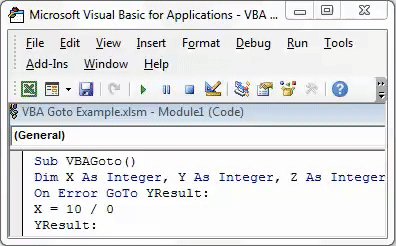
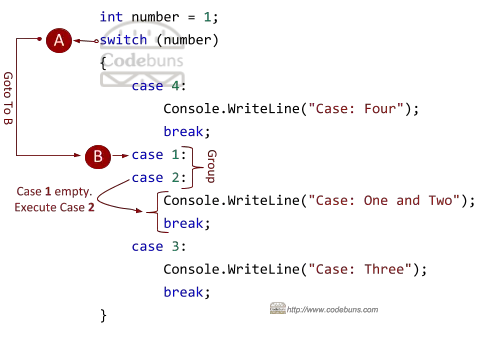


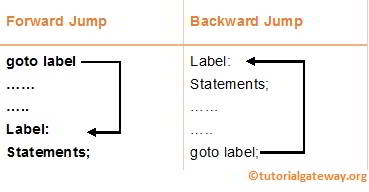

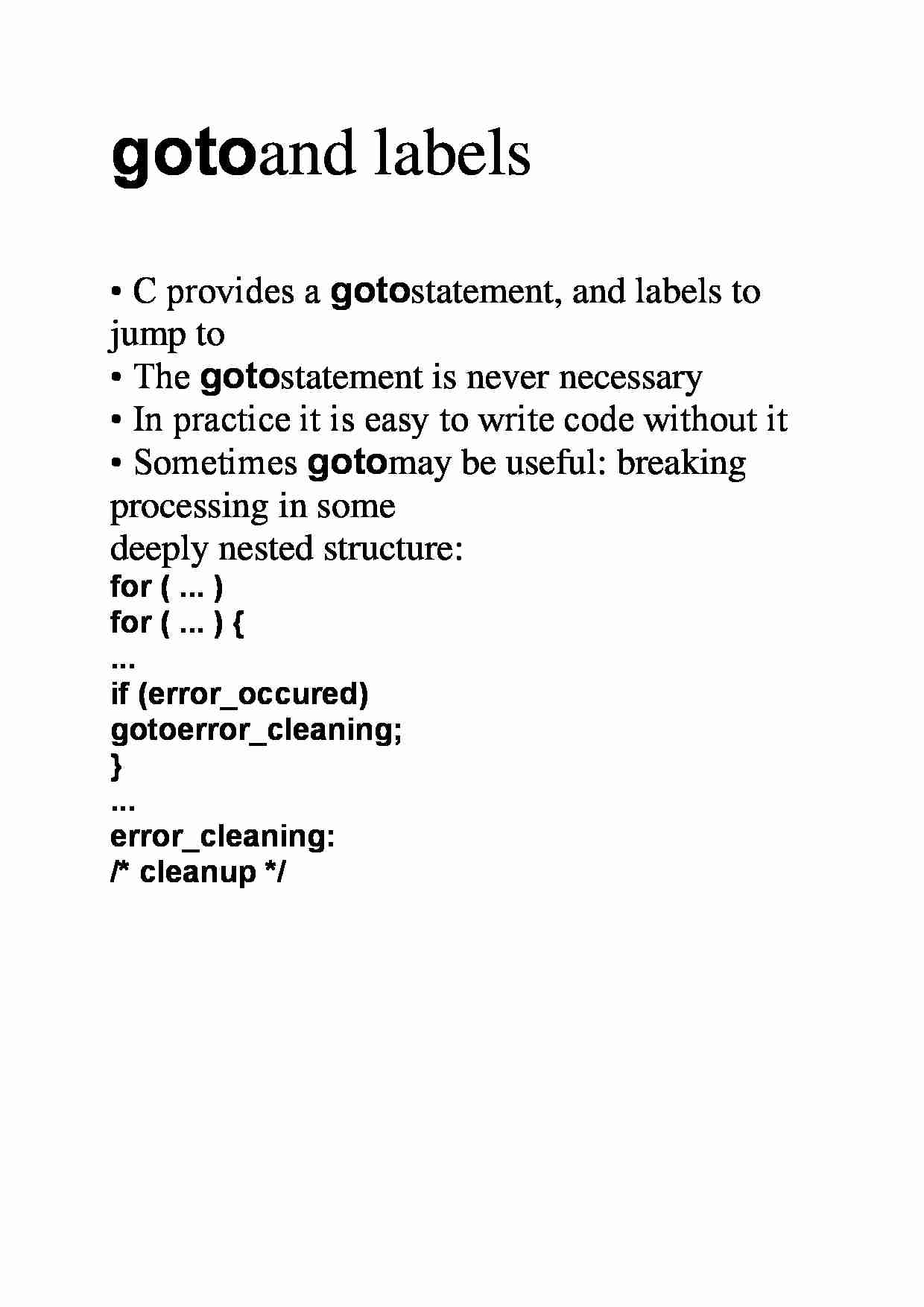

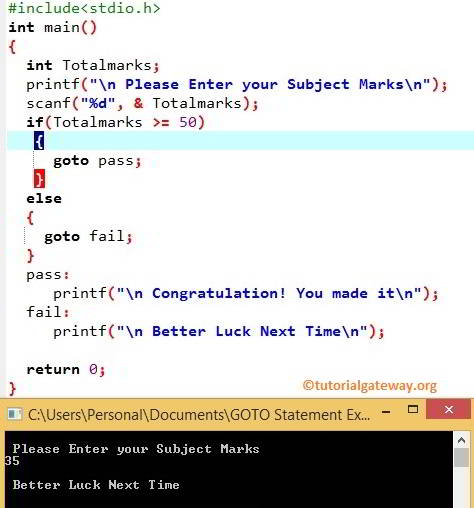
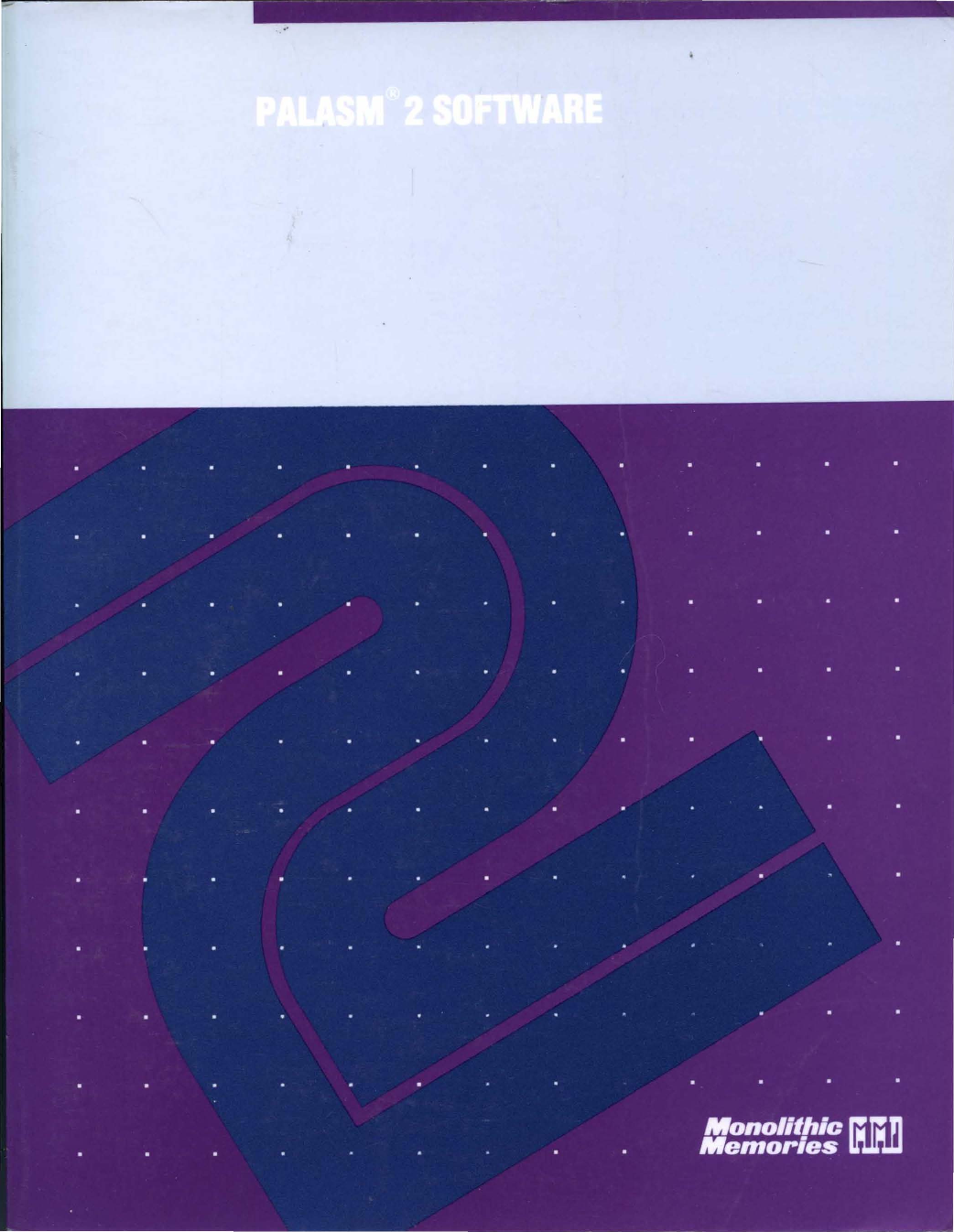
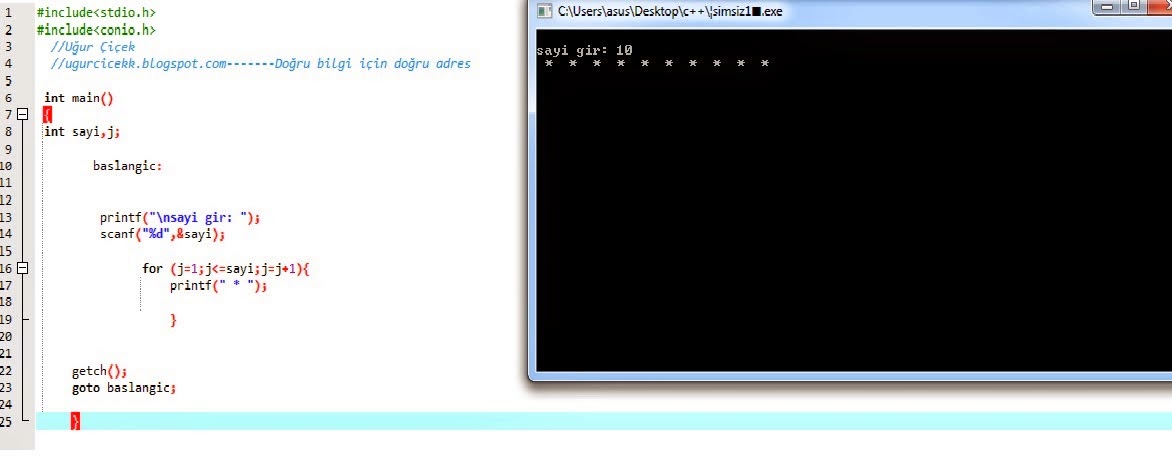


Post a Comment for "41 goto and labels in c"